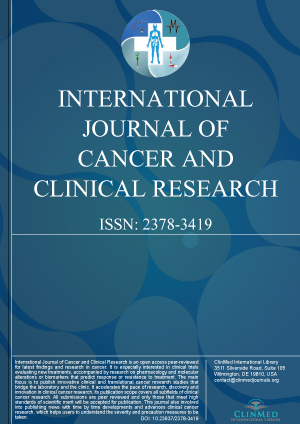Open Access DOI:10.23937/2378-3419/3/2/1054
New Insights into Functional Implication of Genetic Variation in Association with Cancer
Yanfeng Zhang
Article Type: Review Article | First Published: April 16, 2016
Investigations of the genetic basis of cancers have identified hundreds of robust risk loci associated with cancers using large-scale, case-control, candidate gene studies as well as genome-wide association studies (GWASs) during the past ten years. Most leading single nucleotide polymorphisms (SNPs) associated with cancer sensitivity lie in non-protein-coding regions, suggesting the potentially regulatory functions as targets for susceptible variants. That is a critical question to understand t...
Open Access DOI:10.23937/2378-3419/3/2/1053
Prdx Overexpression in Tumor Tissue of Breast Cancer Patients
Jillian Muhlbauer and Shelley A Phelan
Article Type: Original Research | First Published: April 08, 2016
Peroxiredoxin (Prdx) proteins are evolutionarily conserved thiol-specific antioxidant enzymes that reduce various cellular peroxides, protecting cells from oxidative damage. Prdxs also have been demonstrated to play an important role in regulating redox-sensitive cell signaling in a number of cell processes. Prdxs have been implicated in cancer biology, and are upregulated in many cancers including breast cancer, as well as several breast cancer cell lines. To explore the entire Prdx family in b...
Open Access DOI:10.23937/2378-3419/3/2/1052
Relation between Thyroid Disease and Breast Cancer
Ersin Turan and Baris Sevinc
Article Type: Original Article | First Published: March 31, 2016
Benign thyroid nodules are most common surgically treated endocrine disorder. Breast cancer is the most common cancer type among women. In the recent study, we aimed to detect the relation between breast cancer and benign thyroid nodules. The patients operated because of breast cancer and have a definite diagnosis with pathological evaluation were included in this prospective study....
Open Access DOI:10.23937/2378-3419/3/2/1051
Improved Antitumoral Efficacy of Mesothelin Targeted Immune Activating Fusion Protein in Murine Model of Ovarian Cancer
Yang Zeng, Binghao Li, Patrick Reeves, Chongzhao Ran, Zhao Liu, Mojgan Agha-Abbaslou, Jianping Yuan, Pierre Leblanc, Ann Sluder, Jeffrey Gelfand, Timothy Brauns, Mark Poznansky and Huabiao Chen
Article Type: Research Article | First Published: March 30, 2016
The candidate therapeutic fusion protein (scFv-MtbHsp70) is a recombinant Mycobacteria tuberculosis heat shock protein 70 (MtbHsp70) fused with a single chain antibody (scFv) targeting mesothelin, combining the immune-targeting capacity of the scFv with the broader immune activating capabilities of MtbHsp70. The previous version of the fusion protein, VIC-007, markedly enhanced survival of ovarian tumor-bearing mice through the augmentation of tumor-specific cell-mediated immune responses....
Open Access DOI:10.23937/2378-3419/3/2/1050
The Many Faces of Lung Cancer
Luciano Cardinale, Valeria Angelino, Edoardo Piacibello and Andrea Veltri
Article Type: Short Review | First Published: March 27, 2016
The aim of this short review is to illustrate various CT findings of lung cancer (LC) other than the classical aspects. Overall, LC is the second commonest cancer in men and women in the developed world and small cell lung cancer (SCLC) accounts for about 20-25% of cases. In comparison with Non-Small Cell Lung Cancer (NSCLC), SCLC typically exhibits more aggressive behaviour with rapid growth, early metastatic spread and frequent association with paraneoplastic syndromes....
Open Access DOI:10.23937/2378-3419/3/2/1049
Cardiac Involvement in Carcinoid Syndrome: Role of Serial Standard and Contrast Echocardiography
Francesca Casadei, Antonella Moreo, Francesco Musca, Paola Vallerio, Miriam Stucchi and Cristina Gannattasio
Article Type: Case Report | First Published: March 23, 2016
We report a case of a 52 year-old woman with cardiac carcinoid metastases who developed a moderate tricuspid regurgitation without the typical findings of carcinoid valve disease. Echocardiography allowed to define the mechanism of valve insufficiency. Moreover, standard and contrast echocardiography permitted characterization of the structural features of the mass, size measurement and monitoring growth during follow-up....
Open Access DOI:10.23937/2378-3419/3/2/1048
New Enzyme-Targeting Radiosensitizer (KORTUC) Containing Hydrogen Peroxide & Sodium Hyaluronate for Intra-tumoral Injection Using Mice Transplanted with SCC VII Tumor
Ryo Akima, Yasuhiro Ogawa, Shiho Morita-Tokuhiro, Akira Tsuzuki, Shin Yaogawa, Shinji Kariya, Norihiko Hamada, Akihito Nishioka, Shinichiro Masunaga and Koji Ono
Article Type: Original Article | First Published: March 21, 2016
The therapeutic effect of radiotherapy using linear accelerators (Linac) for relatively large tumors of more than several centimeters in diameter is reduced to one- third due to a large number of hypoxic tumor cells and a significant amount of anti-oxidative enzymes, such as many kinds of peroxidases and catalase. To overcome tumor hypoxia and abundant peroxidase activities, an injection of hydrogen peroxide into tumor tissue is considered to be a most effective method. However, this is consider...
Open Access DOI:10.23937/2378-3419/3/2/1047
P53 Sensitizes Breast Cancer Stem Cells to Let-7 miRNAs Induced Repression
Jian Liu, Ning Du, Huangzhen Wang, Xin Wang, Peili Wang, Jia Zhang, Gang Li, Jing Zhang, Sida Qin, Chongwen Xu, Shou-Ching Tang, Xin Sun, Boxiang Zhang, Dapeng Liu and Hong Ren
Article Type: Original Article | First Published: March 10, 2016
Cancer stem cells (CSCs) are responsible for the tumor recurrence and resistance to chemo-radiotherapy. Let-7 family of miRNAs functions in regulating cancer biology by repressing multiple downstream oncogenes. In this study, we examined the regulatory loop of suppressive let-7 and p53 in the pathogenesis of breast cancer, and explored the mechanism through which this loop affects the growth patterns of breast cancer stem-like cells (BrCSCs)....
Open Access DOI:10.23937/2378-3419/3/2/1046
Metronomic Chemotherapy Preserves Quality of Life Ensuring Efficacy in Elderly Advanced Non Small Cell Lung Cancer Patients
Francesca De Iuliis, Stefania Vendittozzi, Ludovica Taglieri, Gerardo Salerno, Rosina Lanza, and Susanna Scarpa
Article Type: Original Article | First Published: March 01, 2016
Metastatic non small cell lung cancers (NSCLC) are diseases with poor prognosis and platinum-based doublet chemotherapy still remains their standard cure. Elderly patients often present comorbidities that limit the utilization of this chemotherapy; therefore these patients should have a first-line treatment with low toxicity and capable to preserve the quality of life (QoL) but, at the same time, to ensure the best possible response. Furthermore, a first-line treatment allows patients to be fit ...

